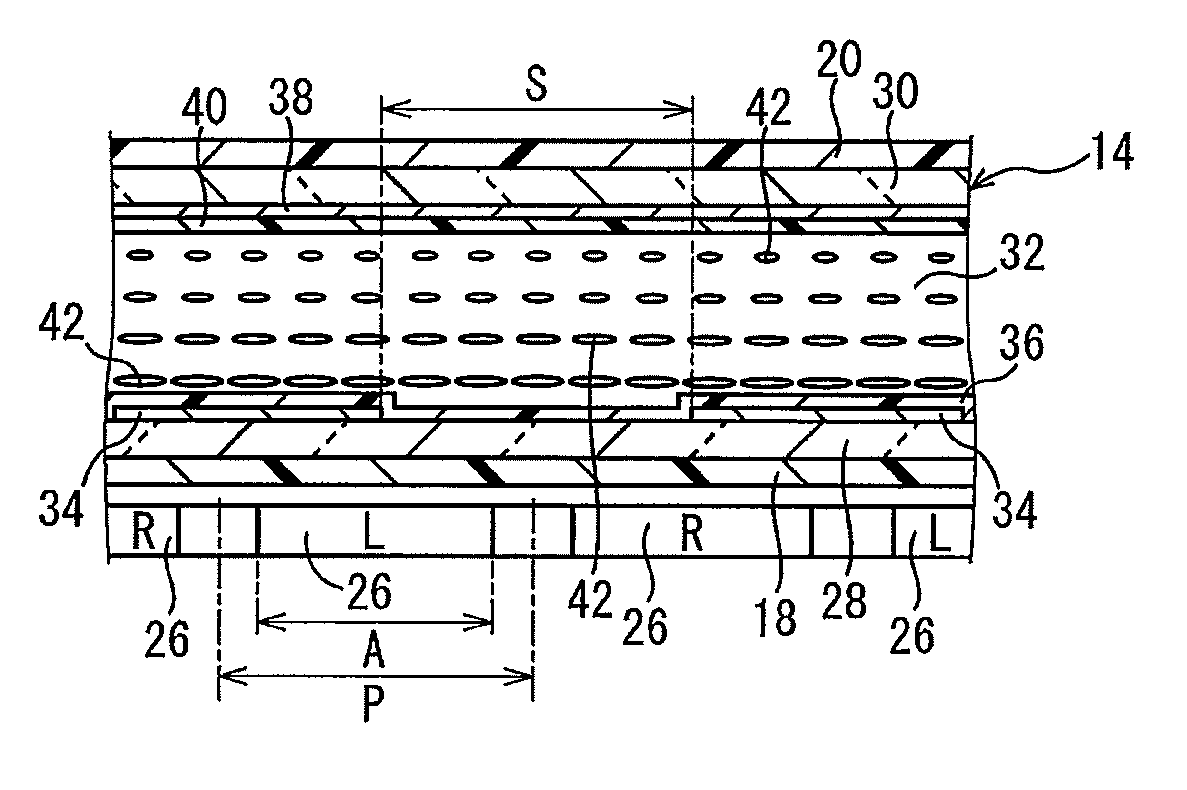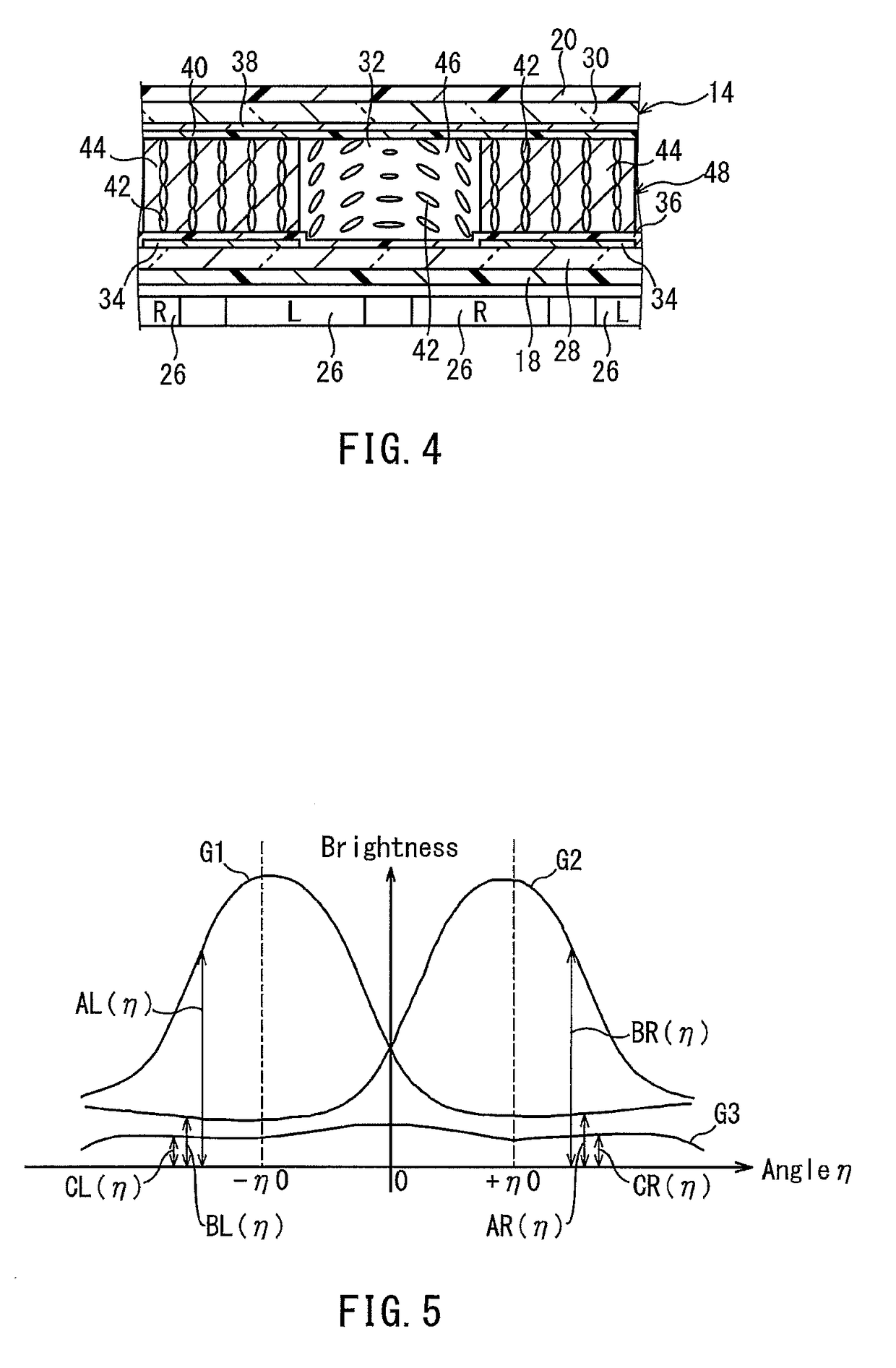Stereoscopic display device
a display device and stereoscopic technology, applied in the field of stereoscopic display devices, can solve the problems of reducing the switching speed between 2d display and 3d display, difficult to keep the cell thickness uniform, and deteriorating the crosstalk ratio, so as to prevent the deterioration of the crosstalk ratio and increase the brightness
- Summary
- Abstract
- Description
- Claims
- Application Information
AI Technical Summary
Benefits of technology
Problems solved by technology
Method used
Image
Examples
embodiment 1
[Embodiment 1]
[0038]FIG. 1 shows a stereoscopic display device 10 as Embodiment 1 of the present invention. The stereoscopic display device 10 includes a display panel 12, a switching liquid crystal panel 14, and polarizing plates 16, 18, and 20.
[0039]The display panel 12 is a liquid crystal panel. The display panel 12 includes an active matrix substrate 22, a counter substrate 24, and a liquid crystal layer 25 sealed between these substrates 22 and 24. In the display panel 12, the liquid crystal is in an arbitrary operation mode.
[0040]The display panel 12 includes a plurality of pixels 26, as shown in FIGS. 2 and 3. The plurality of pixels 26 are formed, for example, in matrix form. The area where the plurality of pixels 26 are formed is a display area of the display panel 12.
[0041]Each pixel 26 may include a plurality of subpixels 26R, 26G, and 26B, as shown in FIG. 2. In the example shown in FIG. 2, red pixels 26R, green pixels 26G and blue pixels 26B are used as the plurality of...
application example
[Application Example of Embodiment 1]
[0078]Though Embodiment 1 has a configuration in which a plurality of subpixels 26R, 26G, and 26B are arrayed in the longitudinal direction of the display area of the display panel 12, the present application example has a configuration in which a plurality of subpixels 26R, 26G, and 26B are arrayed in the lateral direction of the display area of the display panel 12, as shown in FIG. 14. In this case, as shown in FIG. 14, the subpixels contributing to the display of a left eye image and the subpixels contributing to the display of a right eye image are arrayed alternately in the lateral direction of the display area of the display panel 12. In the present application example, “A” in Formula (1) described in the explanation of Embodiment 1 represents the opening width of the subpixels (the dimension thereof in the direction in which the transmission parts 46 and the light-shielding parts 44 are arrayed alternately), and “P” represents the interva...
embodiment 2
[Embodiment 2]
[0079]A stereoscopic display device 50 as Embodiment 2 of the present invention is explained with reference toFIG. 15. The stereoscopic display device 50 of the present embodiment is different from the stereoscopic display device 10 of Embodiment 1 in that a λ / 2 plate 52 is arranged between the polarizing plate 18 and the switching liquid crystal panel 14.
[0080]In the present embodiment, as shown in FIG. 16, an angle δ formed between the transmission axis D4 of the polarizing plate 18 and the reference line L is 63°. The reason why the angle δ is 63° is that the display panel 12 is a liquid crystal panel of the ASV type (in which the operation mode of the liquid crystal is the VA mode and the CPA type). In the liquid crystal panel of the ASV type, preferable viewing angle characteristics are obtained when the angle δ is 63°. The angle o formed between the slow axis D5 of the λ / 2 plate 52 and the reference line L is 54°. The angle β formed between the alignment axis D2 ...
PUM
| Property | Measurement | Unit |
|---|---|---|
| angle | aaaaa | aaaaa |
| angle | aaaaa | aaaaa |
| voltage | aaaaa | aaaaa |
Abstract
Description
Claims
Application Information
 Login to View More
Login to View More - R&D
- Intellectual Property
- Life Sciences
- Materials
- Tech Scout
- Unparalleled Data Quality
- Higher Quality Content
- 60% Fewer Hallucinations
Browse by: Latest US Patents, China's latest patents, Technical Efficacy Thesaurus, Application Domain, Technology Topic, Popular Technical Reports.
© 2025 PatSnap. All rights reserved.Legal|Privacy policy|Modern Slavery Act Transparency Statement|Sitemap|About US| Contact US: help@patsnap.com



